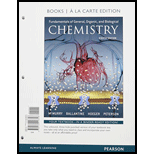
(a)
Interpretation:
The
Concept Introduction:
If a base receives one proton, then the formed species is a conjugate acid whereas an acid lose one proton, then the formed species is a conjugated base.
(b)
Interpretation:
The grams of
Concept Introduction:
Ideal gas Equation:
Any gas can be described by using four terms namely pressure, volume, temperature and the amount of gas. It is referred as ideal gas equation.
Under some conditions gases don not behave like ideal gas that is they deviate from their ideal gas properties. At lower temperature and at high pressures the gas tends to deviate and behave like real gases.
Moles: One mole is equivalent to the mass of the substance consists of same number of units equal to the atoms present in
Want to see the full answer?
Check out a sample textbook solution
Chapter 10 Solutions
Fundamentals of General, Organic, and Biological Chemistry, Books a la Carte Plus Mastering Chemistry with Pearson eText -- Access Card Package (8th Edition)
- Consider the following acids and their ionization constant, determine which conjugate base is HCOOH Ka = 1.7 x 10-4 (b) HCN Ka = 4.9 x 10-10arrow_forwardPropanamide and methyl acetate have about the same molar mass, both are quite soluble in water, and yet the boiling point of propanamide is 486 K, whereas that of methyl acetate is 330 K. Explain.arrow_forwardGiven the balanced equation with an unknown compound represented by X, which compound is represented by X?arrow_forward
- What mass of gallium oxide, Ga2O3, can be prepared from 29.0 g of gallium metal? The equation for the reaction is 4Ga + 3O2 ⟶ 2Ga2 O3.arrow_forwardHow many grams of CuSO4 would you use to make 1 L of an 8 g/L CuSO4 solution?arrow_forwardEthylene glycol, the main ingredient in antifreeze, contains 38.7% carbon, 9.7% hydrogen and 51.6 % oxygen. Calculate the empirical and molecular formulas for ethylene glycol. Given the molar mass is approximately 60 g/mol. A) Empirical formula: B)Molecular formula: Explain how you obtained the Molecular formula (b)?arrow_forward
- A solution contains 2.2 x 10 -3 M in Cu2+ and 0.33 M in LiCN. If the Kf for Cu(CN)42- is 1.0 x 1025 , how much copper ion remains at equilibrium?arrow_forwardFerrous sulfate is one dietary supplement used to treat iron-deficiency anemia. What are the molecular formula and molecular mass of this compound? howmany milligrams of iron are in 250 mg of ferrous sulfate?arrow_forwardHow many mL of 0.254 M NaOH are needed to fully react with 37.50 mL of 0.358 M H2SO4?arrow_forward
- In the Equation: HCO3- + HCl --------> Conjugate Acid + Conjugate Base a ) Which reactant is the Acid? b) Which reactant is the Base? c) What Conjugate Acid will form in this reaction? d) What Conjugate Base will form in this reaction?arrow_forwardFor in the solution part for c), do you mean 6.25%?arrow_forwardwhat is the conjugate acid for the following reaction? HC2HO4 + H2O <--> H3O+ + C2HO4- A)C2HO4- B) HC2HO4 C)H2O D) H3O+arrow_forward
 Principles Of Radiographic Imaging: An Art And A ...Health & NutritionISBN:9781337711067Author:Richard R. Carlton, Arlene M. Adler, Vesna BalacPublisher:Cengage Learning
Principles Of Radiographic Imaging: An Art And A ...Health & NutritionISBN:9781337711067Author:Richard R. Carlton, Arlene M. Adler, Vesna BalacPublisher:Cengage Learning
